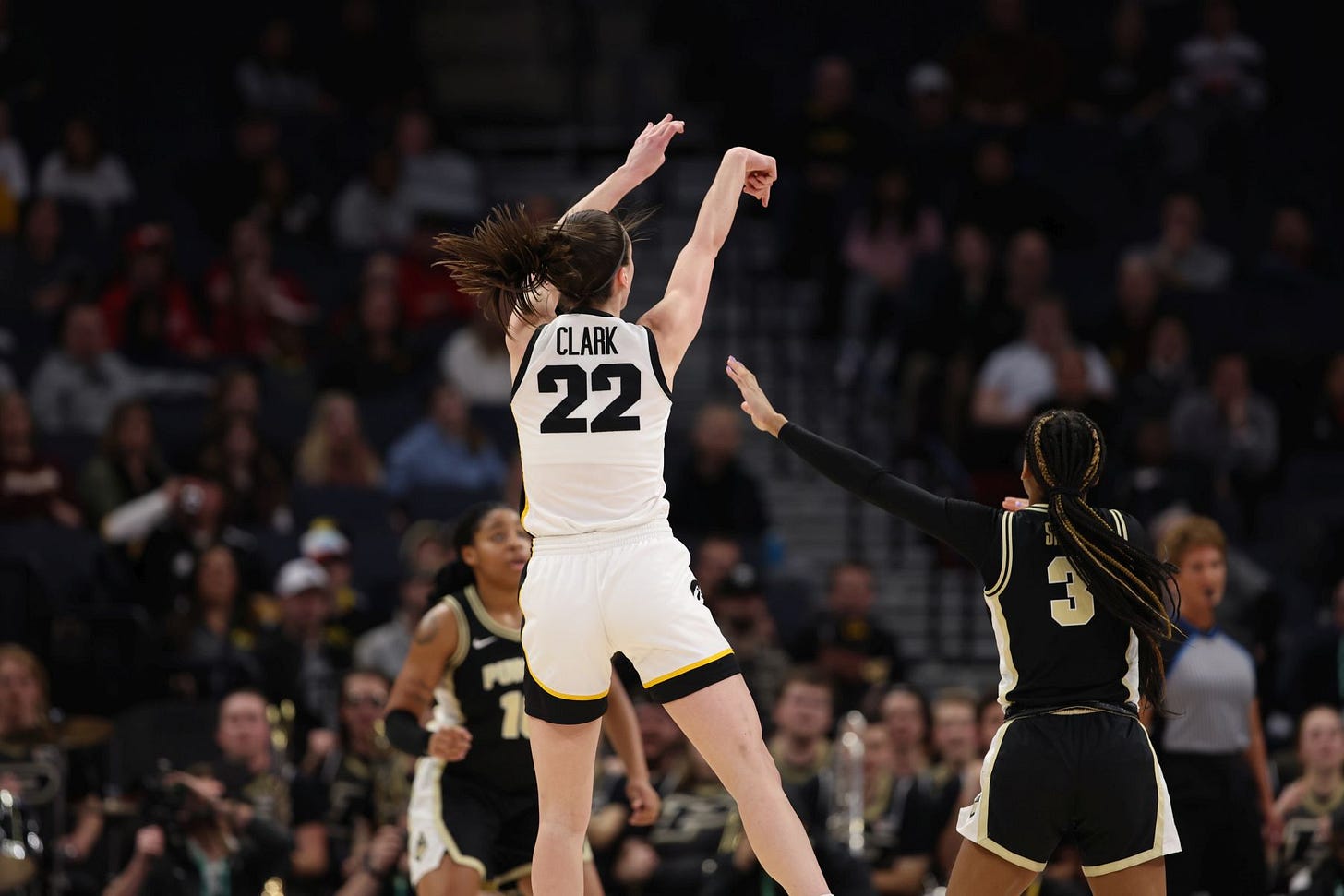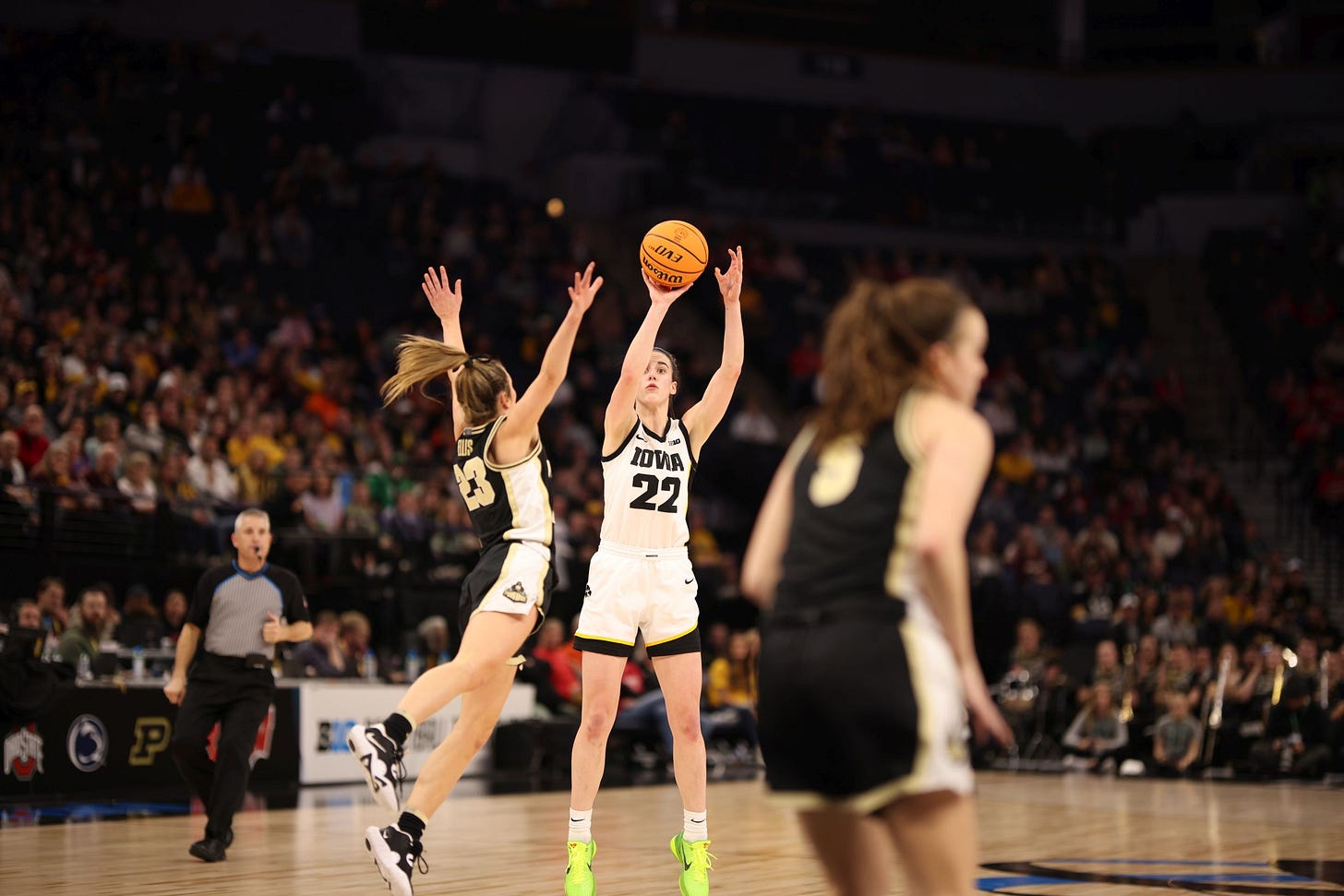
It’s raining today in Caitlin Clark Town.
I’m standing and looking up at a seven-story billboard of her shooting a basketball toward a different billboard several blocks away where a basket waits. You’ve probably seen it already. There’s a similar one in Times Square.
That’s where #22 is right now: New York, somewhere in Albany, preparing to play tonight in front of the largest audience of her life. This, a rematch of last year’s National Championship, is expected to set the record for women’s basketball television viewership. Modern American marketing being as pervasive as it is, I don’t really need to tell you any of that. Sports are at their best hyperbole manifested, and so here we are. Don’t forget that this game, this night is exactly what the NCAA had in mind when they put this bracket together.
“It’s raining today in Caitlin Clark Town” I think while I push my bicycle in the rain up a hill, still wearing my helmet on my head. #22 is top of mind mainly because of the big billboard back there, but also because it’s impossible to exist anywhere near here and not have her somewhat always in your consciousness. I have honestly held off writing about #22 for so long because she has come to dominate such a large part of this Iowa life that it's frightening. I’ve never before been there at ground level and part of a real, bonafide cultural phenomenon that sees personal lives planned around tipoff schedules and broadcast streams.
Sara and I got hooked early. The first women’s basketball game we went to, this happened:
I told her that night that it wasn’t always like this, with buzzer beaters and sell-out crowds and just really, really great basketball to watch. In the last year, through the efforts of #22 and this team, I’ve been made a liar night in and night out.
Last month, Sara went to Minneapolis for the Big Ten Tournament. She even shelled out for two tickets to the round of 64 game held right here in Caitlin Clark Town. This from a woman who has hated watching basketball for the entirety of her adult life. “Loathed” it. That’s the real effect of #22: an ability to translate a series of viral athletic moments into an intense, and both consistent and persistent, fandom.

Carver Hawkeye Arena is about a mile and a half from the grocery store where I work. For the better part of two years, the women who play there have become the dominant matter of speech among the aisles, during downtime at the registers. I’m reminded of the ability of sport to organize, to unify, to distract. Her ability, this program, this game tonight, I realize now that it’ll be one of the last things that we can all collectively talk about for many months to come. There will be a cavalcade of horrors all the way until November, even after. Tonight, win or lose, her story begins its natural move away from Caitlin Clark Town and towards a more rarefied air.
I imagine that in a few hours, we will watch as #22 fully metastasizes from sporting figure to cultural vein, if she hasn't become one already. Your various content feeds have surely been doing their best to lay the groundwork already.
“What’s it like to be #22 at 22?” this ESPN profile asks her repeatedly over the course of nearly 18,000 words. (It is the most in-depth one-off profile of a single athlete that I’ve read in years.) And there was this piece in The Atlantic that categorized the economic impact that #22 has on the game of basketball, on the local economies of the cities of opposing teams, and also on herself.

Last week, for our anniversary, while I was supposed to be hiking with Sara and looking for fallen deer antlers, I sat in front of a TV and thought about #22. What else was at play here, beyond her actual basketball talent and personal ability, that has contributed to her ascent? I made a real doe-eyed list of factors, ill-equipped as I am to write about basketball and everything it encapsulates.
I wrote them out with bullet points for some reason, so I’ll include them here that same way:
She doesn’t play at UCONN, or some similar perennial women’s basketball powerhouse. Iowa women’s basketball doesn’t have an established character arc, at least not in the national consciousness. Still, there’s an unshakeable, if faulty underdog-ness to #22’s story. She plays for Iowa, where she’s also from. It says it right there on her chest. Whatever that conjures up in your mind, about the state or the region or its people, is certainly at the heart of whatever #22 is selling. Or rather what whoever is selling #22 wants you to think about her.
There is no way to think meaningfully about Caitlin and not think about race. To wit: there’s only one person I know personally that wants LSU to win, and she’s Black, which says plenty about the state of our American culture generally and the various expectations made of women in sports in particular. It is not a coincidence that #22 is a devout Catholic from a capital city suburb who went to a private school. The fixation on Caitlin and the individual “Caitlin Cam” that often appears during game broadcasts has caught plenty of her tantrums and referee complaints and trash-talking. Many, including Angel Reese, have rightfully pointed out the disparity of grace given to her by officials in comparison to other women’s players. No surprises here, but privilege begets more privilege, even in sport. Especially in sport. "The crown she wears is heavy" her teammate Kate Martin says, as if we weren’t the ones who gave it to her.

Caitlin’s popularity today stems from the fact that her talent was largely kept a secret throughout her first two pandemic-era seasons, her legend kept local for the most part. I remember when my boss, who’s had season tickets from the beginning, told me that I had to watch this woman play basketball. It was during the Christmas holiday shopping season, 2022. That’s when I started paying attention. I have to reiterate that we were only two miles away from where it was taking place. Ever since at the store we’ve kept track of the women’s basketball home games to prepare for how all those #22 t-shirt jerseys affect the amount of mangoes and Danish pastries we can sell. Her emergence now coincides some with a re-marketing of athletes in general, especially college athletes through NIL deals, and a broader resurgence of sports fandom, a relic from our collective desperation for pandemic time distractions. Her ability to grow and sustain that media attention comes from her own consistency both on the court and in the public eye. (There is one local story that one of the Starbucks workers asked her for her name when she ordered a drink there, and Caitlin got mad. Which is objectively funny on all fronts, but especially so because the basketball from the seven story billboard has to cross directly over that Starbucks to get to where the billboard hoop hangs.)
Since Day 1 in the town known formerly as Iowa City, #22 has had the green light to shoot from wherever, whenever, and to play her style of basketball and hers alone. Basketball purists have long known that the women’s sport was where to find a traditional, “no-nonsense” game, with all the problematic racial and gender and societal ramifications that arise with that distinction. Fundamentals first. Solid defense. All those stereotypes and jokes you’ve heard before about jump balls and free throws. A “conservative” game, in every sense of the word. But the green light that #22 has been given allows her, and by default the team around her, to play a fast, up-tempo type of basketball that feels more punk rock than it actually is. My boss calls it a “flow state.” There are very few frustration or tempo timeouts taken in Iowa games, and there is no #22 as she exists now without Lisa Bluder’s approach to coaching her, which has largely been to stay the hell out of Caitlin’s way until her presence is absolutely necessary. It’s a beautiful chaos, this Iowa basketball, one that scores lots of points collectively and obviously individually as well, which at the end of the collective day, it turns out we all really want to watch.
All the bars and frat houses and dorm rooms will be having watch parties in Caitlin Clark Town tonight. Raygun will be selling their shirts. This town will continue expanding in ways it won’t be able to realize for years because of its women’s basketball team and because of #22.
Greg Brown once called this place a “boomtown” and it probably is for some at least.
The rich build sensitive houses and pass their staff around
For the rest of us, it's trailers on the outskirts of town
We carry them their coffee, wash their shiny cars
Hear all about just how lucky we are
To be living in a …Boomtown
We got another Boomtown
And it'll boom
Just as long as the boom has room
Tonight we’ll be watching from our home on the outskirts of Caitlin Clark Town. We couldn’t afford it there before she arrived, and definitely won’t be able to now that she’s leaving.
In nearly all measurable basketball statistics, Caitlin Clark has already claimed the big door prize.
But she hasn’t won a national championship, and she’s never beaten LSU. Not yet.
All was quiet today in Caitlin Clark Town. It won’t be tonight.




